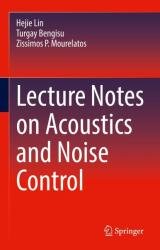 Название: Lecture Notes on Acoustics and Noise Control
Название: Lecture Notes on Acoustics and Noise ControlАвтор: Hejie Lin, Turgay Bengisu
Издательство: Springer
Год: 2022
Страниц: 381
Язык: английский
Формат: pdf (true)
Размер: 12.1 MB
This textbook provides a guide to the fundamental principles of acoustics in a straightforward manner using a solid foundation in mathematics and physics. It is designed for those who are new to acoustics and noise control, and includes all the necessary material for a comprehensive understanding of the topic. It is written in lecture-note style and can be easily adapted to an acoustics-related one semester course at the senior undergraduate or graduate level. The book also serves as a ready reference for the practicing engineer new to the application of acoustic principles arising in product design and fabrication.
Lecture Notes on Acoustics and Noise Control provides a mathematical backbone for acoustics and noise control. This mathematical foundation is comprised of straightforward mathematical derivations and formulations of sound waves. All formulations are built from the acoustic wave equation based on the kinetic theory of gases. The mathematical formulations are condensed into a minimalistic yet complete acoustic foundation for a one-semester course. The formulations covered in this book can be used as reliable references for researchers and engineers working in the field of acoustics and noise control.
This book is written in a course notes format for a one-semester course of “acoustics and noise control.” This course is offered to senior undergraduates and beginning graduate students without a prior background of acoustics or noise control. The materials in this book are compiled from a series of noise, vibration, and harshness (NVH) courses taught by the authors of this book during the past 14 years at Oakland University.
Straightforward derivations of formulations are presented in the course notes. When the derivation of formulas is the main objective of a section, the final formulas are placed at the beginning of that section to serve as a compass of derivation. The properties of sound can be observed and understood through the derivation of the formulation. Class examples and homework are included to support and reinforce the derivations. Through the derivations, examples, and homework, students can understand the physics behind the formulas.
Two significant projects in numerical analysis of sound propagation are included in this course. The first project revolves around numerically calculating the sound pressure induced by a vibrating plate. This project requires students to understand the formulations for acoustic point sources and apply them to the real-world situations. The first project concludes the fundamental acoustics theory in the first half of the course. The second project requires numerical calculation of the sound power transmission in pipes. This project requires students to understand the formula for power transmission in pipes as filters and apply them to real-world problems. The second project concludes the filter design in the second half of the course.
Includes full review of mathematical formulas and procedures needed to comprehend acoustic principles;
Reinforces concepts presented with Matlab exercises and 100 end of chapter problems;
Based on class-tested course notes.
Prerequisites:
Students should have a basic knowledge of practical experience with calculus and differential equations.
Contents:
1. Complex Numbers for Harmonic Functions
2. Derivation of Acoustic Wave Equation
3. Solutions of Acoustic Wave Equation
4. Acoustic Intensity and Specific Acoustic Impedance
5. Solutions of Spherical Wave Equation
6. Acoustic Waves from Spherical Sources
7. Resonant Cavities
8. Acoustic Waveguides
9. Sound Pressure Levels and Octave Bands
10. Room Acoustics and Acoustical Partitions
11. Power Transmission in Pipelines
12. Filters and Resonators
Скачать Lecture Notes on Acoustics and Noise Control